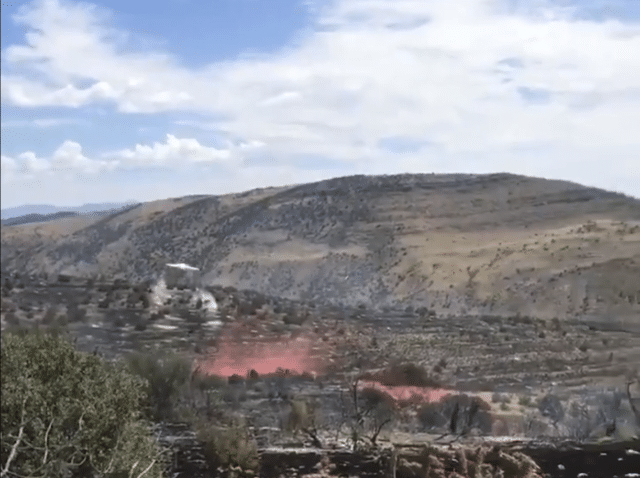Fire Fighting and Rising Terrain
The following clip was posted to Twitter on the 13th of August.
Oh F*** pic.twitter.com/235hlKFAHr
— Aviões e Músicas (@avioesemusicas) August 13, 2019
The video shows a small four-engine jet coming in low to drop fire retardant and then climbing away over a low ridge, flying so close to the rising terrain that the aircraft visibly disturbs the dust in the final frames.

Fire Aviation identified the aircraft as a British Aerospace 146 (BAe146) known as Neptune’s Tanker 01, on contract to the US Forest Service.
One commenter asked about the the fact that there’s little or no smoke/flames in the area. The response from Doug sheds some light on this:
We do a lot of drops where there are no smoke and flames; sometimes to support a line that’s being put in such as reinforcing a dozer line, sometimes to work ahead of a line going in, sometimes to pre-treat an area, sometimes to extend a line ahead to prevent fire spread, sometimes to reinforce an area where the line is weak or inaccessible by ground crews, etc.
Hard to say what’s really going on with the fire tactics without a bigger picture a knowledge of what the fire personnel were dealing with at that exact time. There’s often a lot of change from the time the tanker is requested to when it shows up, or from the time we leave a fire to when we return; the fire may have reversed direction, winds may have shifted, fire behavior may have picked up or died down. It’s possible that a storm is moving in, with anticipation of a wind increase or shift, and drops begin in advance of that wind change. It’s also possible that when a video is shot, we’re seeing only a portion of the fire; the active fire may be elsewhere and this may be tying off a spot fire, isolating a fire run, protecting a terrain feature such as a ridge or draw or island etc, or there may be something specific in the drop area that needs additional protection.
I’ve dropped in the middle of fires when there’s containment on the outside, for cattle, structures, and other things that are within the fire interior; the fire may be burning elsewhere but that doesn’t mean it’s secure inside the fire line. We turned a herd of cows in Montana pink once, that would have otherwise likely been killed (and the rancher threatened to sue…).
Angles, elevations, etc, can all look different than what they actually are, thanks to the perspective of the photographer, and a lack of overall context. Remember that here, we’re not seeing what the crew saw in the cockpit.
That may be true but the disturbance of the dust makes it clear that they are much too close to the ground.
And the flight crew clearly agree, as can be seen on the SAFECOM report. SAFECOM is the Aviation Safety Communique and this is where the US Forest Service report their aviation mishaps. The report can be found under the category Hazard: Pilot Action.
SAFECOM 19-0415 submitted 1 August 2019
NARRATIVE
While conducting retardant operations I descended below a ridge crossing altitude. This was NOT on purpose. I tunnel visioned the drop, and continued down. This was a little fill in spot and I was really focused on finishing the line. As I stated, this was NOT on purpose. We {crew} debriefed and talked about what happened, and of course, how to prevent this type of screw up. Thanks
CORRECTIVE ACTION
Crew will review SOP`s, CRM, etc. RASM: Glad to see the crew realized and admitted what occurred. Hope to see others follow suit as narratives like this remind us all to be diligent.
I presume from the phrasing that the report was filed after the flight crew saw the video as they seem rather adamant to explain that they were not intentionally showboating or flying close to terrain.
Nice to see a happy ending as well as a very nice demonstration of the issues of high workloads leading to channelised attention. The only thing I would have liked to see is a reference to how the workload could have been split between the two in order to ensure that the distance above the terrain was monitored, especially in a situation like this where EGPWS is sounding off too constantly to be of any use.








Notice how the pilot rolls slightly right in order to align his wings with the ridgeline. He may have been caught by surprise but he made exactly the correct move to avoid contact with terrain.
That made my tummy flip! Just finished Sylvia’s newest Without a Trace book. Really enjoyed the Bass Strait story as I had never heard it before.
In regard to MH370, I don’t know any more than anyone else does about the cause but I found this article in The Atlantic compelling https://www.theatlantic.com/magazine/archive/2019/07/mh370-malaysia-airlines/590653/